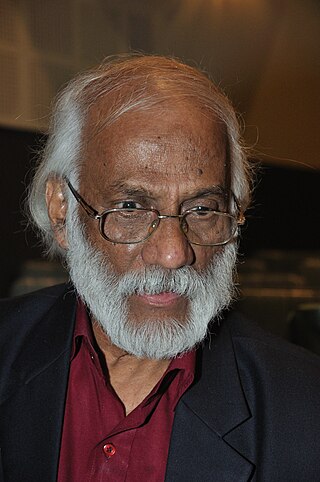Related Research Articles

Malaria is a mosquito-borne infectious disease that affects vertebrates. Human malaria causes symptoms that typically include fever, fatigue, vomiting, and headaches. In severe cases, it can cause jaundice, seizures, coma, or death. Symptoms usually begin 10 to 15 days after being bitten by an infected Anopheles mosquito. If not properly treated, people may have recurrences of the disease months later. In those who have recently survived an infection, reinfection usually causes milder symptoms. This partial resistance disappears over months to years if the person has no continuing exposure to malaria.
Antimalarial medications or simply antimalarials are a type of antiparasitic chemical agent, often naturally derived, that can be used to treat or to prevent malaria, in the latter case, most often aiming at two susceptible target groups, young children and pregnant women. As of 2018, modern treatments, including for severe malaria, continued to depend on therapies deriving historically from quinine and artesunate, both parenteral (injectable) drugs, expanding from there into the many classes of available modern drugs. Incidence and distribution of the disease is expected to remain high, globally, for many years to come; moreover, known antimalarial drugs have repeatedly been observed to elicit resistance in the malaria parasite—including for combination therapies featuring artemisinin, a drug of last resort, where resistance has now been observed in Southeast Asia. As such, the needs for new antimalarial agents and new strategies of treatment remain important priorities in tropical medicine. As well, despite very positive outcomes from many modern treatments, serious side effects can impact some individuals taking standard doses.

Plasmodium falciparum is a unicellular protozoan parasite of humans, and the deadliest species of Plasmodium that causes malaria in humans. The parasite is transmitted through the bite of a female Anopheles mosquito and causes the disease's most dangerous form, falciparum malaria. It is responsible for around 50% of all malaria cases. P. falciparum is therefore regarded as the deadliest parasite in humans. It is also associated with the development of blood cancer and is classified as a Group 2A (probable) carcinogen.

Artemisinin and its semisynthetic derivatives are a group of drugs used in the treatment of malaria due to Plasmodium falciparum. It was discovered in 1972 by Tu Youyou, who shared the 2015 Nobel Prize in Physiology or Medicine for her discovery. Artemisinin-based combination therapies (ACTs) are now standard treatment worldwide for P. falciparum malaria as well as malaria due to other species of Plasmodium. Artemisinin is extracted from the plant Artemisia annua a herb employed in Chinese traditional medicine. A precursor compound can be produced using a genetically engineered yeast, which is much more efficient than using the plant.

Plasmodium knowlesi is a parasite that causes malaria in humans and other primates. It is found throughout Southeast Asia, and is the most common cause of human malaria in Malaysia. Like other Plasmodium species, P. knowlesi has a life cycle that requires infection of both a mosquito and a warm-blooded host. While the natural warm-blooded hosts of P. knowlesi are likely various Old World monkeys, humans can be infected by P. knowlesi if they are fed upon by infected mosquitoes. P. knowlesi is a eukaryote in the phylum Apicomplexa, genus Plasmodium, and subgenus Plasmodium. It is most closely related to the human parasite Plasmodium vivax as well as other Plasmodium species that infect non-human primates.
An apicoplast is a derived non-photosynthetic plastid found in most Apicomplexa, including Toxoplasma gondii, and Plasmodium falciparum and other Plasmodium spp., but not in others such as Cryptosporidium. It originated from algae through secondary endosymbiosis; there is debate as to whether this was a green or red alga. The apicoplast is surrounded by four membranes within the outermost part of the endomembrane system. The apicoplast hosts important metabolic pathways like fatty acid synthesis, isoprenoid precursor synthesis and parts of the heme biosynthetic pathway.
Malaria vaccines are vaccines that prevent malaria, a mosquito-borne infectious disease which annually affects an estimated 247 million people worldwide and causes 619,000 deaths. The first approved vaccine for malaria is RTS,S, known by the brand name Mosquirix. As of April 2023, the vaccine has been given to 1.5 million children living in areas with moderate-to-high malaria transmission. It requires at least three doses in infants by age 2, and a fourth dose extends the protection for another 1–2 years. The vaccine reduces hospital admissions from severe malaria by around 30%.

Govindarajan Padmanaban is an Indian biochemist and biotechnologist. He was the former director of the Indian Institute of Science (IISc), and presently serves as honorary professor in the department of biochemistry at IISc and Chancellor of Central University of Tamil Nadu.

The history of malaria extends from its prehistoric origin as a zoonotic disease in the primates of Africa through to the 21st century. A widespread and potentially lethal human infectious disease, at its peak malaria infested every continent except Antarctica. Its prevention and treatment have been targeted in science and medicine for hundreds of years. Since the discovery of the Plasmodium parasites which cause it, research attention has focused on their biology as well as that of the mosquitoes which transmit the parasites.

Haemozoin is a disposal product formed from the digestion of blood by some blood-feeding parasites. These hematophagous organisms such as malaria parasites, Rhodnius and Schistosoma digest haemoglobin and release high quantities of free heme, which is the non-protein component of haemoglobin. Heme is a prosthetic group consisting of an iron atom contained in the center of a heterocyclic porphyrin ring. Free heme is toxic to cells, so the parasites convert it into an insoluble crystalline form called hemozoin. In malaria parasites, hemozoin is often called malaria pigment.
PfATP6, also known as PfSERCA or PfATPase6, is a calcium ATPase gene encoded by the malaria parasite Plasmodium falciparum. The protein is thought to be a P-type ATPase involved in calcium ion transport.

Sangeeta N. Bhatia is an American biological engineer and the John J. and Dorothy Wilson Professor at MIT’s Institute for Medical Engineering and Science and Electrical Engineering and Computer Science (EECS) at the Massachusetts Institute of Technology (MIT) in Cambridge, Massachusetts, United States. Bhatia's research investigates applications of micro- and nano-technology for tissue repair and regeneration. She applies ideas from computer technology and engineering to the design of miniaturized biomedical tools for the study and treatment of diseases, in particular liver disease, hepatitis, malaria and cancer.
Atovaquone/proguanil, sold under the brand name Malarone among others, is a fixed-dose combination medication used to treat and prevent malaria, including chloroquine-resistant malaria. It contains atovaquone and proguanil. It is not recommended for severe or complicated malaria. It is taken by mouth.
Pregnancy-associated malaria (PAM) or placental malaria is a presentation of the common illness that is particularly life-threatening to both mother and developing fetus. PAM is caused primarily by infection with Plasmodium falciparum, the most dangerous of the four species of malaria-causing parasites that infect humans. During pregnancy, a woman faces a much higher risk of contracting malaria and of associated complications. Prevention and treatment of malaria are essential components of prenatal care in areas where the parasite is endemic – tropical and subtropical geographic areas. Placental malaria has also been demonstrated to occur in animal models, including in rodent and non-human primate models.
Russell J. Howard is an Australian-born executive, entrepreneur and scientist. He was a pioneer in the fields of molecular parasitology, especially malaria, and in leading the commercialisation of one of the most important methods used widely today in molecular biology today called “DNA shuffling" or "Molecular breeding", a form of "Directed evolution".

Julian Charles Rayner is a New Zealand malaria researcher, and the Director of the Cambridge Institute for Medical Research, part of the University of Cambridge School of Clinical Medicine. He is also Director of Wellcome Connecting Science. He was previously a member of academic Faculty at the Wellcome Sanger Institute.

Ganaplacide is a drug in development by Novartis for the purpose of treating malaria. It belongs to the class of the imidazolopiperazines. It has shown activity against the Plasmodium falciparum and Plasmodium vivax forms of the malaria parasite.
Yagya Dutta Sharma is an Indian molecular biologist, professor and head of the department of biotechnology at the All India Institute of Medical Sciences, Delhi. An elected fellow of all three major Indian science academies — Indian National Science Academy, Indian Academy of Sciences, and National Academy of Sciences, India — Sharma is known for his research on the molecular biology of malaria. The Council of Scientific and Industrial Research, the apex agency of the Government of India for scientific research, awarded him the Shanti Swarup Bhatnagar Prize for Science and Technology for his contributions to medical sciences in 1994.
Wai-Hong Tham is a Malaysian professor at the University of Melbourne and the Walter and Eliza Hall Institute of Medical Research (WEHI), and joint head of the division of Infectious Disease and Immune Defense. She researches the molecular biology of the malaria parasite Plasmodium vivax.
Susan L. Perkins is an American microbiologist and the Martin and Michele Cohen Dean of Science at The City College of New York (CCNY). Her expertise includes the pathology and genetics of malaria parasites and other haemosporidians infecting myriad non-primate species.
References
- ↑ "Chemistry in Action: Jacquin Niles | MIT OpenCourseWare | Free Online Course Materials". ocw.aprende.org. Retrieved 2019-04-16.
- 1 2 "Engineering foe into friend". MIT News. Retrieved 2019-04-16.
- 1 2 "Jacquin Niles named director of the Center for Environmental Health Sciences". MIT News. Retrieved 2019-04-16.
- ↑ "Niles Laboratory". web.mit.edu. Retrieved 2019-04-16.
- ↑ Burney, Samar; Caulfield, Jennifer L.; Niles, Jacquin C.; Wishnok, John S.; Tannenbaum, Steven R. (1999). "The chemistry of DNA damage from nitric oxide and peroxynitrite". Mutation Research/Fundamental and Molecular Mechanisms of Mutagenesis. 424 (1–2): 37–49. doi:10.1016/S0027-5107(99)00006-8. PMID 10064848.
- ↑ Niles, Jacquin. "Minority Predoctoral Fellowship Program - NIGMS".
{{cite journal}}: Cite journal requires|journal=(help) - ↑ Niles, Jacquin. "Engineered Regulated RNA Localization and Transport in Biological Systems".
{{cite journal}}: Cite journal requires|journal=(help) - ↑ "Niles Laboratory". web.mit.edu. Retrieved 2019-04-16.
- ↑ "Faculty Scholars Program". HHMI.org. Retrieved 2019-04-16.
- ↑ Han, Jongyoon; Suresh, Subra; Niles, Jacquin C.; Dao, Ming; Goldfless, Stephen J.; Diez-Silva, Monica; Pivkin, Igor V.; Bow, Hansen (2011-02-28). "A microfabricated deformability-based flow cytometer with application to malaria". Lab on a Chip. 11 (6): 1065–1073. doi:10.1039/C0LC00472C. ISSN 1473-0189. PMC 3366288 . PMID 21293801.
- ↑ "Generous funding to malaria-parasite researcher promises new therapeutic strategies". EurekAlert!. Retrieved 2019-04-16.
- ↑ Rasmussen, Ray (2017-03-01). "Taking Aim at a Key Malaria Molecule". Science and Technology Research News. Retrieved 2019-04-16.
- ↑ "Easier way to manipulate malaria genes". ScienceDaily. Retrieved 2019-04-16.
- ↑ in-pharmatechnologist.com. "Re-engineering the malaria parasite for drug delivery". in-pharmatechnologist.com. Retrieved 2019-04-16.
- 1 2 3 MIT Alumni Association (2017-06-28), MIT Technology Day 2017: Professor Jacquin Niles '94, PhD '01 , retrieved 2019-04-16
- ↑ "Generous funding to malaria-parasite researcher promises new therapeutic strategies". EurekAlert!. Retrieved 2019-04-16.
- ↑ "Duke researchers discover how malaria parasites withstand a fever's heat". Duke Today. Retrieved 2020-11-18.